1. INTRODUCTION
A cosmic ray neutron monitor (NM) is a ground-based detector that measures the count of secondary cosmic ray neutrons. The primary cosmic ray particles detectable by neutron monitors typically have energies ranging from approximately 500 MeV to several GeV (Bütikofer 2018). This energy range is closely linked to solar modulation phenomena, such as ground level enhancements (GLEs) and Forbush decreases (FDs). FDs are characterized by a sudden drop followed by a gradual recovery in cosmic ray intensity, as observed by NMs. These events are caused by magnetic barriers formed by interplanetary shocks and interplanetary coronal mass ejections (ICMEs) (Lockwood 1971). Conversely, GLEs are characterized by a sudden increase in cosmic ray intensity due to the arrival of solar energetic particles (SEPs) (Oh et al. 2012).
The NM was first designed in the early 1950s by Simpson (1958) as part of the International Geophysical Year (IGY) initiative. This IGY-type NM served as the standard instrument for studying cosmic rays during the 1957–1958 campaign. Subsequently, Hatton & Carmichael (1964) developed the NM64 neutron monitor, which featured an improved counting rate. The NM64 neutron monitor became the standard instrument during the International Quiet Sun Year (IQSY) of 1964–1965 and continues to be widely used today.
The global NM network plays a critical role in solar and space environment research and monitoring. These monitors provide real-time, cost-effective, and reliable ground-based measurements of cosmic ray intensity. Currently, approximately 50 NM stations are in operation worldwide. The Neutron Monitor Database (NMDB) is a real-time database for high-resolution NM measurements and provides access to NM data from stations across the globe (https://www.nmdb.eu/).
In South Korea, the cosmic ray research group operates two NMs: one at Jang Bogo Station in Antarctica, operational since 2015 (Jung et al. 2016), and another originally located in Daejeon, South Korea since 2011 (Kang et al. 2012). The Jang Bogo NM station has geomagnetic coordinates and cutoff rigidity nearly identical to those of the former McMurdo NM station. The Jang Bogo NM succeeded the McMurdo NM, which was relocated to Jang Bogo Station, and Jeong & Oh (2022) confirmed that it inherited over 60 yr of observational continuity. Recently, the NM formerly located in Daejeon was relocated to Mt. Gamak in Geochang, South Korea. This study introduces the details and implications of that relocation.
2. NEUTRON MONITOR AT MT. GAMAK IN GEOCHANG
The Daejeon NM was installed at the Korea Research Institute of Standards and Science (KRISS) in Daejeon through a collaborative effort between Hanyang University and Chungnam National University in October 2011 (Kang et al. 2012). Since then, both Daejeon and Jang Bogo NMs have been operated and studied by Chonnam National University. As the principal investigator (PI) institution for the NM stations, Chonnam National University provides cosmic ray data from both NMs through be NMDB network. Oh & Kang (2013) reported the diurnal variation of cosmic rays observed at the Daejeon NM, showing a peak phase around 13:00 local time (LT). In a later study, Kang et al. (2016) identified 37 FDs over the period 2012–2014 and found that the Daejeon NM exhibited smaller intensity variations and shorter main phase durations compared to those observed at the Oulu NM.
Relocation of the Daejeon NM became necessary due to maintenance issues. The relocation officially began in 2023, in collaboration with the Korea Astronomy and Space Science Institute (KASI), a leading organization in solar and space environment research in South Korea. The disassembly process started in the summer of 2023, and reinstalled at the Satellite Laser Ranging (SLR) station at Mt. Gamak in Geochang (Figs. 1 and 2). The SLR station provides distances to Earth-orbiting satellites using pulse lasers and laser retroreflector arrays and plays an important role in South Korea’s space missions (Lim et al. 2017, 2018).
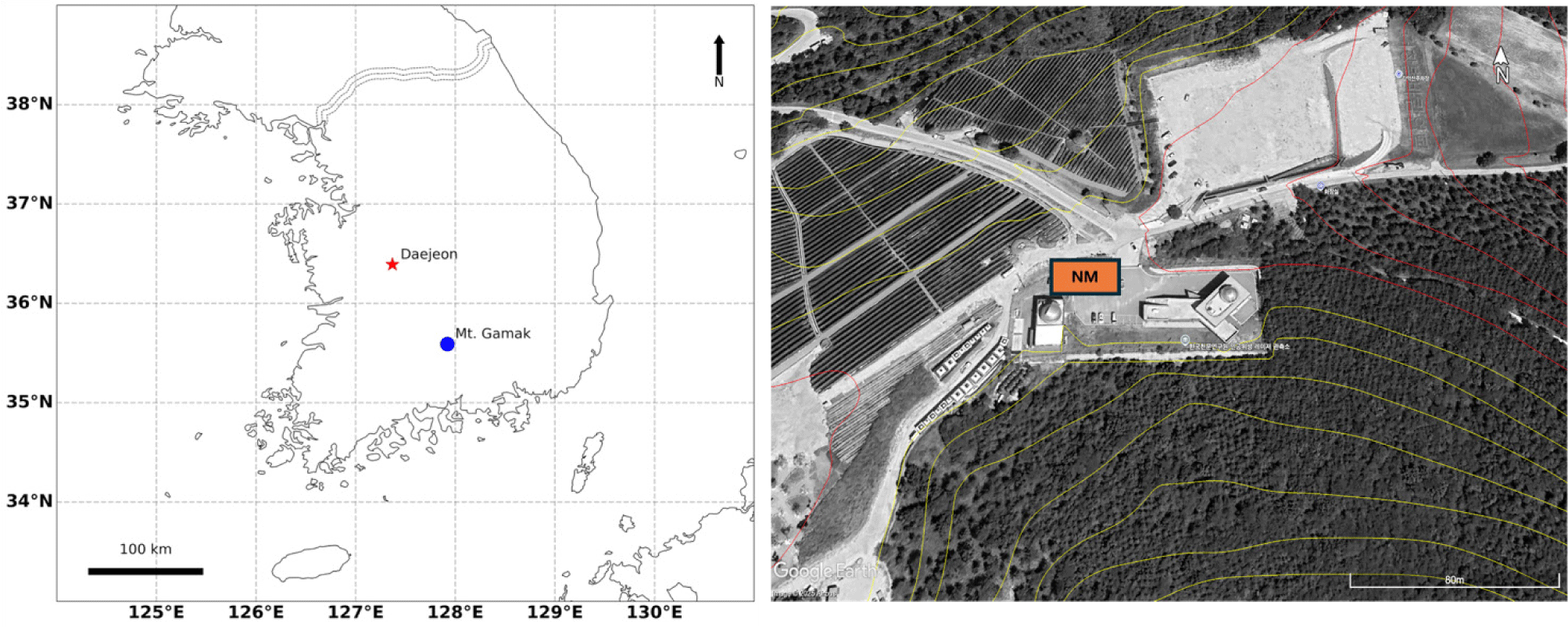
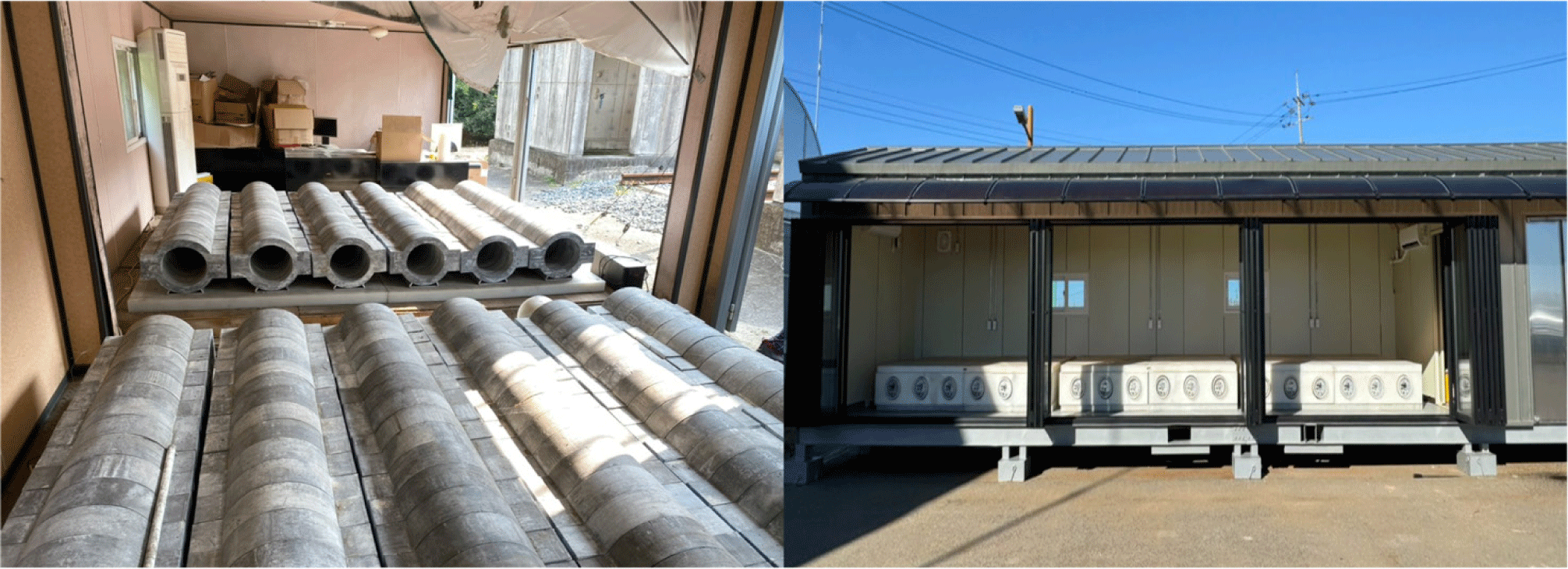
To facilitate data sharing and cooperation, a memorandum of understanding (MOU) for the use of observational data from the Mt. Gamak NM was signed by KASI, Hanyang University, Chonnam National University, and Chungnam National University.
The Mt. Gamak NM retains the same basic configuration and detailed specifications as previous Daejeon NM, as it was directly relocated from that site. It is an NM64-type monitor, consisting of a reflector, moderator, lead producer, and 18 counter tubes (Kang et al. 2012).
Table 1 provides geographic and geomagnetic coordinates, as well as cutoff rigidity values, for Korean neutron monitors. Mt. Gamak is located approximately 100 km from Daejeon. The geomagnetic coordinates were obtained using the British Geological Survey (BGS) geomagnetic coordinate calculator (https://geomag.bgs.ac.uk/data_service/models_compass/coord_calc.html). The cutoff rigidity for Daejeon was previously calculated using the International Geomagnetic Reference Field (IGRF) model for epoch 2010.0 (Kang et al. 2012). The cutoff rigidity at Mt. Gamak is 11.0 GV, derived using the Oulu-Open-source Geomagnetosphere Propagation Tool (OTSO), which utilizes both IGRF and geodipole field models (Larsen et al. 2023). For this study, only the IGRF model for epoch 2015.0 was used. Using the same approach, the cutoff rigidity at Daejeon was estimated to be 10.6 GV. Thus, the geographic and geomagnetic characteristics of the Daejeon and Mt. Gamak NMs are nearly identical.
The NM does not detect primary cosmic rays directly, but instead measure secondary cosmic rays produced when primary cosmic rays interact with particles in the Earth's atmosphere. Also, these secondary particles can be absorbed or lost as they pass through the atmosphere. Therefore, NM data must be normalized through barometric correction to account for the effects of atmospheric pressure. The barometric coefficient, which depends on both atmospheric pressure and the station’s cutoff rigidity, can be estimated from the linear relationship between cosmic ray intensity and atmospheric pressure (Dorman 1974). This relationship can be expressed as follows.
Where, dI represents the change in the measured cosmic ray intensity, and dP is the change in atmospheric pressure, and −β is the barometric coefficient. This equation can be integrated to give:
Taking the natural logarithm of both sides yields:
Throughout this study, “cosmic ray intensity” specifically denotes the count rate measured by the NM.
Fig. 3 shows the uncorrected count rate (blue) and atmospheric pressure (red) recorded at Mt. Gamak from September to December 2024. The previously reported barometric coefficient for Daejeon station was –0.6557%/hPa (Kang et al. 2012). Fig. 4 illustrates the linear relationship between hourly cosmic ray intensity and hourly atmospheric pressure at Mt. Gamak during the same period, yielding a preliminary barometric coefficient of –0.7101%/hPa (R2 = 0.79). The differential pressure is defined as the difference between the observed pressure at a given time and a reference pressure. Typically, the average pressure value over a representative time interval is used as the reference pressure. Ideally, transient solar effects such as FDs or GLEs should be excluded when determining the barometric coefficient. However, the observation period overlaps with the peak of Solar Cycle 25, characterized by elevated and persistent solar activity, making difficult to isolate such events. The linear relationship does not appear clearly due to solar activities. As more data are accumulated, a more accurate estimation of the barometric coefficient will become possible.
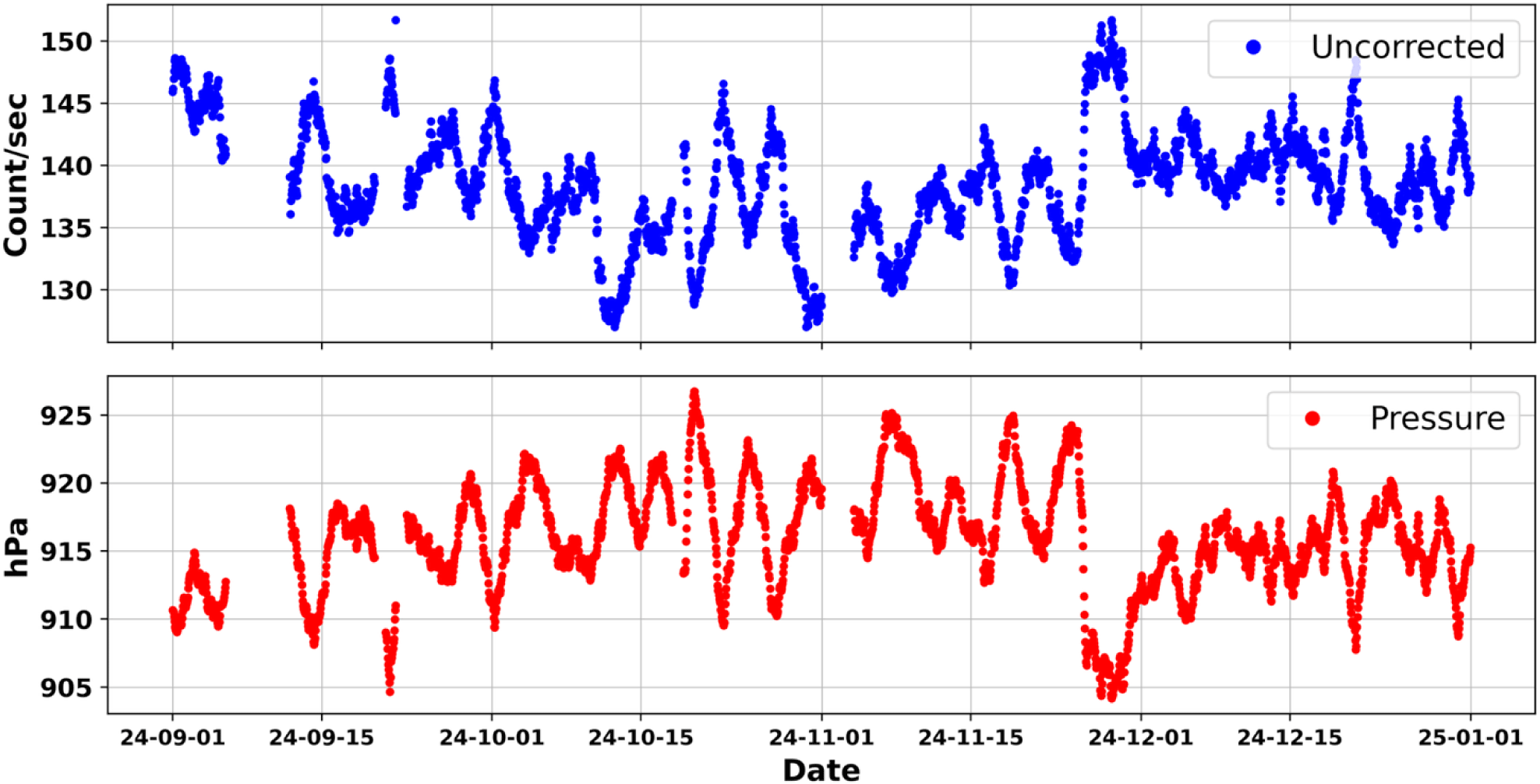
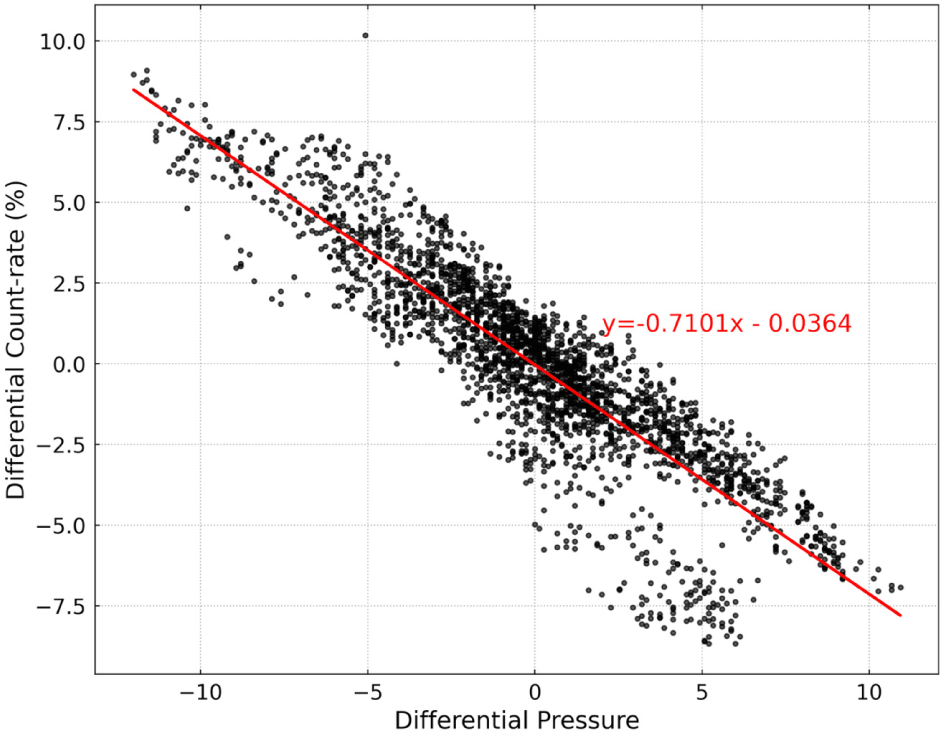
3. RESULTS
Since cosmic rays are predominantly charged particles, they propagate toward Earth along the interplanetary magnetic field lines shaped by the solar magnetic field. The cosmic ray intensity measured by NMs exhibits a diurnal variation due to several factors, including solar activity, Earth’s magnetic field, and its rotation. For the Daejeon NM, the diurnal variation reaches a maximum around 13:00 LT (Oh & Kang 2013; Kang et al. 2016). Fig. 5 presents the diurnal variation of cosmic ray intensity observed at the Mt. Gamak NM during the period from September to December 2024. The blue line represents the original diurnal variation derived using the pile-up method (Oh et al. 2010), while the red and green lines indicate the results obtained through sine fitting and harmonic analysis fitting, respectively. The pile-up method involves stacking and averaging the hourly count rates of cosmic ray intensity for each day to derive the mean diurnal variation. To analyze the diurnal variation in cosmic ray intensity, we applied a sinusoidal fit to the data. This approach allows for a straightforward estimation of the amplitude and phase of the variation. In addition, we employed a harmonic approximation function as described by Kudela et al. (2008), which enables a more detailed characterization of the temporal structure of the diurnal variation. It provides a more detailed characterization of the temporal structure of the diurnal variation. Similar to the Daejeon NM, the Mt. Gamak NM also shows a maximum diurnal intensity around 14:00 LT, with a minimum occurring at approximately 03:00 LT. Oh et al. (2010) reported that the maximum time of the diurnal variation shows solar cyclic dependence, tending to be delayed during solar maximum periods. We suggest that the approximately one-hour delay in the diurnal maximum of cosmic ray intensity observed at Gamak may be attributed to the elevated solar activity during the solar maximum period in Solar Cycle 25.
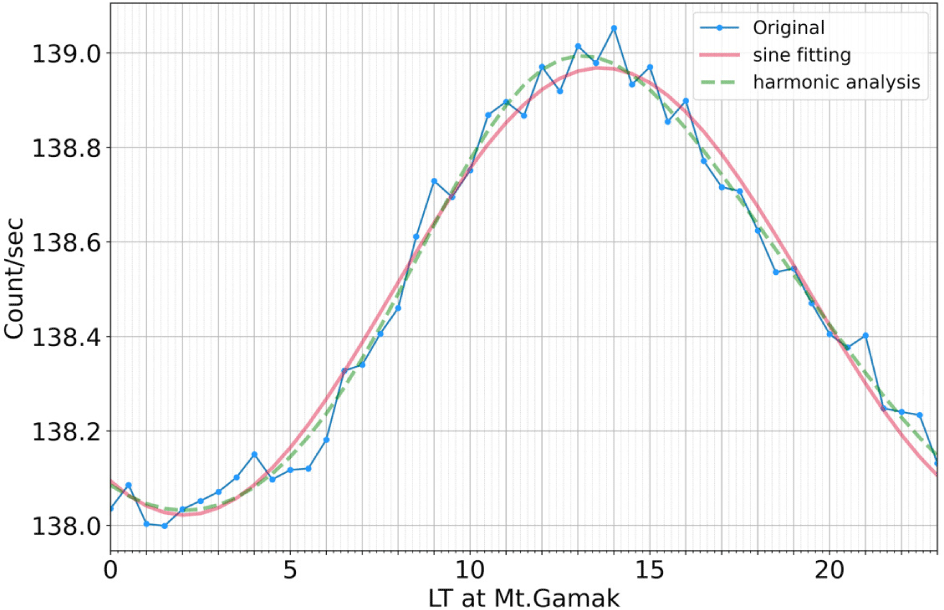
Fig. 6 shows a comparison of the relative neutron flux between the Daejeon and Mt. Gamak stations. The relative neutron flux values were calculated using the online flux calculator available at http://www.seutest.com/cgi-bin/FluxCalculator.cgi. The red and blue lines present the relationship between elevation and the relative neutron flux (RNF) for locations of Mt. Gamak and Daejeon, respectively. The difference between the two lines is mainly due to the difference in geomagnetic latitude. The calculation assumes an average solar modulation level of 50% (where 0% corresponds to the minimum flux during solar maximum and 100% corresponds to the maximum flux during solar minimum). The relative neutron flux is expressed as a ratio to the sea-level neutron flux in New York City, USA, under average solar modulation conditions (Clem & Dorman 2000; Gordon et al. 2004). According to this calculation, the theoretical neutron flux at Mt. Gamak is 1.71 times higher than at Daejeon.
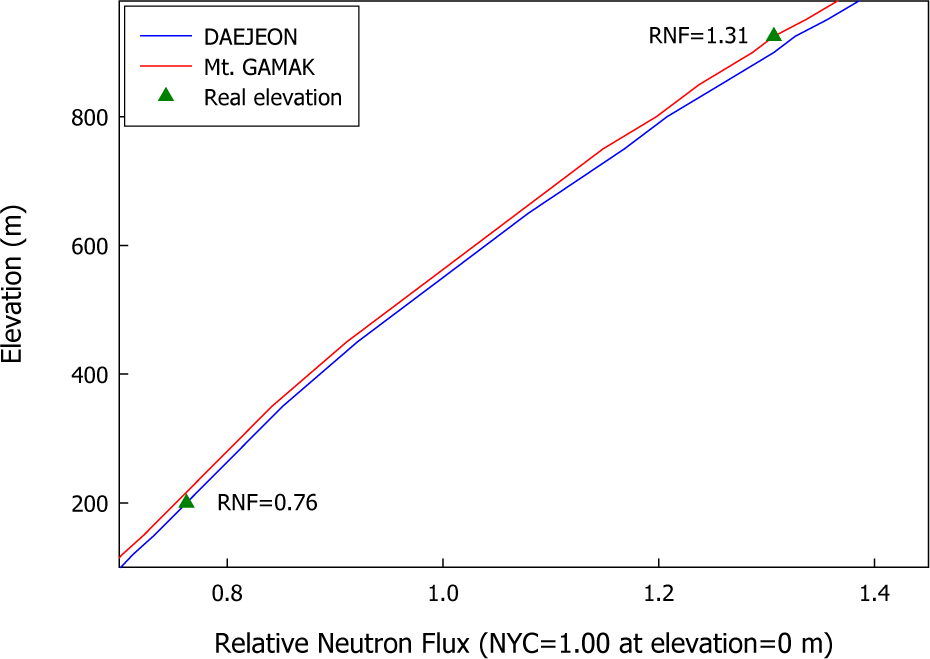
As noted above, the distance between Daejeon and Mt. Gamak is only about 100 km, and the two stations are located at nearly the same geographic and geomagnetic coordinates. However, due to the significantly higher altitude of Mt. Gamak more than four times that of Daejeon, differences in atmospheric pressure and count rates are observed. The average atmospheric pressure at the Daejeon station was 1001.1 hPa, whereas at Mt. Gamak it was 915.9 hPa during the period from September to December 2024. The average count rate per tube at Daejeon was approximately 7.7, while at Mt. Gamak it was approximately 13.8, representing a 1.79-fold increase. The observed increase agrees well with the theoretical prediction for the relative neutron flux. The enhanced count rate can be attributed to the relocation of the neutron monitor to a higher-altitude site. At higher altitudes, the lower atmospheric density allows primary cosmic rays to more effectively interact with atmospheric nuclei, resulting in the efficient production of secondary cosmic rays. However, as these secondary particles travel downward, the increasing atmospheric density leads to greater interaction and absorption, causing their flux to gradually diminish. Therefore, the Mt. Gamak station is expected to provide statistically robust and reliable neutron monitor data.
Fig. 7 presents the time profiles of hourly cosmic ray intensity recorded at the Mt. Gamak (located in middle latitude) and Jang Bogo (located in Antarctic) stations from September to December 2024. The blue and red lines represent the measurements from Mt. Gamak and Jang Bogo stations, respectively. Data gaps at both stations in Fig. 7 are due to maintenance activities. FDs are typically recorded simultaneously by globally distributed NMs. However, in some cases, they may appear non-simultaneously due to the propagation direction of magnetic structures such as interplanetary shocks and magnetic clouds (Oh et al. 2008; Oh & Yi 2009). The FDs shown in Fig. 7 are examples of simultaneous events. As shown, the two NMs exhibit similar patterns of temporal variation. Notably, FDs associated with ICMEs are clearly identified at both stations in October and December. Differences in count rates between two stations can be attributed to variations in geomagnetic location, cutoff rigidity, and the number of NM tubes used at each station. These results confirm that the Mt. Gamak station is capable of providing statistically reliable cosmic ray data, as evidenced by the clear detection of FDs.
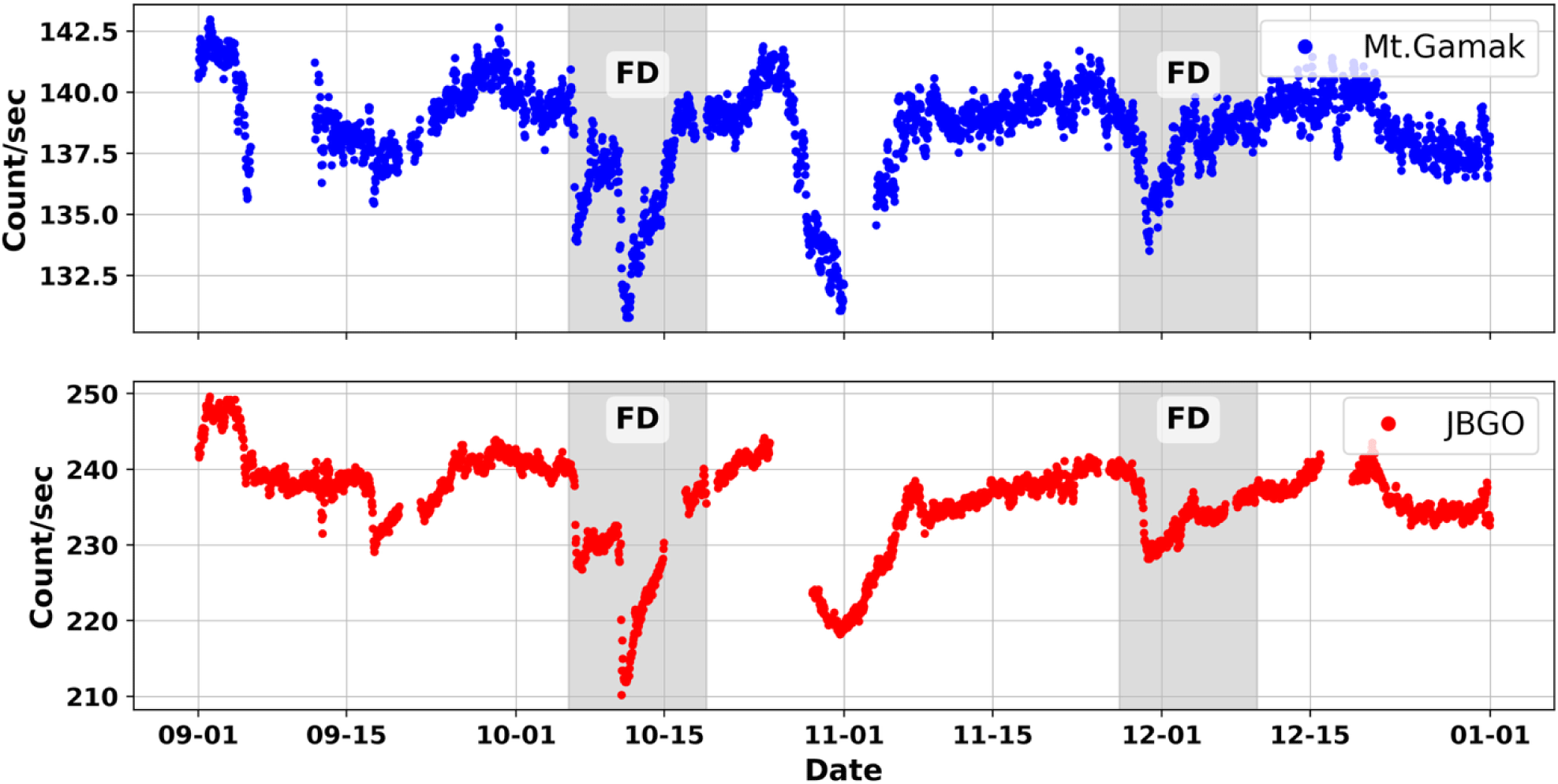
4. SUMMARY AND CONCLUSIONS
The cosmic ray NM is a ground-based detector that measures the secondary cosmic ray neutrons produced by primary particles with energies ranging from approximately 500 MeV to several GeV, an energy range strongly influenced by solar activity. NMs are highly effective instruments for studying and monitoring the solar and space environment. Currently, about 50 stations are operational worldwide. South Korea operates two such stations: one previously located in Daejeon, South Korea, and another at the Jang Bogo station in Antarctica. Recently, the Daejeon NM was relocated to Mt. Gamak in Geochang, South Korea, and is currently operated by the KASI.
The Mt. Gamak NM is situated at a geographic latitude of 35.59°N, a longitude of 127.92°E, and an altitude of approximately 925 meters, with a corresponding cutoff rigidity of 11.0 GV. Analysis of data collected from September to December 2024 indicates an average atmospheric pressure of approximately 915.9 hPa and an average count rate per tube of around 13.8. This count rate is nearly twice as high as that observed at the former Daejeon site, aligning well with theoretical predictions. The increased count rate is primarily due to the lower atmospheric pressure at the higher altitude of Mt. Gamak, as well as improved observational conditions relative to the previous location. The calculated barometric coefficient for the Mt. Gamak site is –0.7101%/hPa. The Mt. Gamak NM also shows a clear diurnal pattern, with maximum intensity occurring around 14:00 LT and a minimum near 03:00 LT. Currently, solar activity is elevated near the maximum of Solar Cycle 25, leading to frequent occurrences of FDs and GLEs, and resulting in greater variability in cosmic ray intensity. As additional data are collected, a more accurate determination of the barometric coefficient will be possible.
Looking ahead, we plan to establish a real-time cosmic ray monitoring system within the KASI infrastructure. Additionally, we aim to collaborate with the NMDB (Mavromichalaki et al. 2011) to enhance data accessibility for the global research community. Ongoing collaborative research will also continue with the Bartol Research Institute and the Thailand cosmic ray group. With the current peak of Solar Cycle 25, numerous solar activity events are occurring. Notably, a G5-level geomagnetic storm, the strongest in 21 yr, was recorded in May 2024 (Kwak et al. 2024). Positioned in the mid-latitude region of East Asia, the Mt. Gamak NM in Geochang is expected to play a pivotal role in solar-terrestrial research and make significant contributions to the global understanding of space weather.
